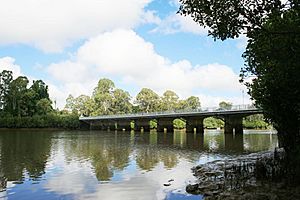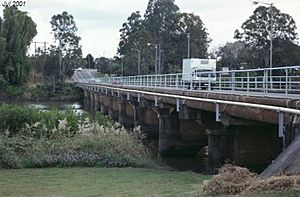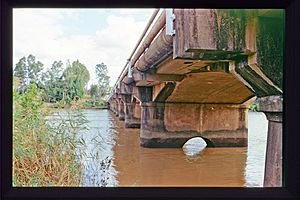Lamington Bridge facts for kids
Quick facts for kids Lamington Bridge |
|
|---|---|

Lamington Bridge, from north-east, 2009
|
|
| Coordinates | 25°32′40″S 152°41′14″E / 25.5445°S 152.6872°E |
| Carries | Motor vehicles |
| Crosses | Mary River |
| Locale | Maryborough & Tinana, Queensland, Australia |
| Heritage status | Queensland Heritage Register |
| Preceded by | highset timber bridge (1874 - 1893) |
| Characteristics | |
| Design | Arch bridges |
| Material | Reinforced concrete |
| Total length | 182.6 metres (599 ft) |
| Width | 6 metres (20 ft) |
| Number of spans | 11 (16.6 metre each) |
| History | |
| Designer | Alfred Barton Brady |
| Constructed by | AcArdle and Thompson |
| Construction begin | 1894 |
| Construction end | 1896 |
| Opened | 30 October 1896 |
| Lamington Bridge | |
|---|---|
| Lua error in Module:Location_map at line 420: attempt to index field 'wikibase' (a nil value). | |
| Location | Gympie Road Tinana across the Mary River to Ferry Street, Maryborough, Fraser Coast Region, Queensland, Australia |
| Design period | 1870s - 1890s (late 19th century) |
| Built | c. 1896 - 1970 |
| Architect | Alfred Barton Brady |
| Official name: Lamington Bridge | |
| Type | state heritage (built) |
| Designated | 21 October 1992 |
| Reference no. | 600721 |
| Significant period | 1890s (fabric) |
| Significant components | pier/s (bridge), kerbing and channelling |
| Builders | McArdle & Thompson |
The Lamington Bridge is a special road bridge in Queensland, Australia. It crosses the Mary River, connecting the towns of Tinana and Maryborough. This bridge is very old and important, so it is listed on the Queensland Heritage Register.
It was designed by a famous engineer named Alfred Barton Brady. Construction started around 1894 and finished in 1896. The Lamington Bridge is one of the first bridges in Australia to be made from concrete. It replaced an older wooden bridge that was destroyed by big floods in 1893. The new concrete bridge was built lower to the ground on purpose. This design helps it survive floods better, as floating tree branches and other debris are less likely to damage it. The bridge was officially opened on October 30, 1896, and was named after Lord Lamington, who was the Governor at that time.
Contents
Building the Lamington Bridge
The Lamington Bridge connects Tinana to Maryborough across the Mary River. It was built using a design by Alfred Barton Brady and opened in 1896. This bridge replaced an older wooden bridge that was built in 1874. The Lamington Bridge is known as one of Australia's oldest concrete bridges.
Maryborough was an important port city in the past. It helped transport goods like wool and timber. It was also a key link for the Gympie goldfield, which was a major gold mining area.
Why a New Bridge Was Needed
The first bridge over the Mary River was made of timber and built in 1874. It was located upstream from where the Lamington Bridge is now. In 1893, huge floods hit the area. These floods badly damaged the timber bridge. This cut off the important road that connected Gympie to the port of Maryborough. Because of this, a new, stronger bridge was needed.
The Engineer Behind the Design
The new bridge was designed by Alfred Barton Brady. He was born and trained in England and became one of Queensland's most important early engineers. He worked for the Queensland Government for 37 years, starting in 1885. He designed many important bridges and buildings.
Besides the Lamington Bridge, Brady also designed other famous bridges. These include the Granville Bridge in Maryborough and the Burnett Bridge in Bundaberg. The Lamington Bridge is considered one of his most clever designs because of how it was built.
Choosing Concrete for Strength
Alfred Barton Brady chose concrete for the Lamington Bridge for good reasons. He said that concrete would make the bridge "very strong, almost everlasting." This meant it would last a very long time and need very little money spent on repairs each year.
The bridge was also designed to be low to the ground. This was a smart idea for flood-prone areas. High bridges can be easily damaged by large pieces of wood or other things floating in floodwaters. A lower bridge is less likely to be hit by such debris. Brady wrote a detailed report about how the bridge was designed and built in 1900.
Construction and Opening
The design for the bridge was ready in 1893. Companies were invited to bid for the building project in September 1894. The company that won the job was McArdle and Thompson from Brisbane.
The bridge cost about £25,000 to build, which was a lot of money back then. It was opened to traffic on October 30, 1896. The opening ceremony was led by David Hay Dalrymple, who was the Minister for Public Works. The bridge was named in honor of Baron Lamington, who was the Governor of Queensland at the time.
In 1970, the Lamington Bridge was made wider to handle more traffic. However, the original handrails were kept and reused.
How the Bridge is Built
The Lamington Bridge is a low-level bridge, meaning it's designed to be covered by water during floods. It crosses the Mary River just south of Maryborough.
It is made of reinforced concrete. This means concrete with steel bars inside to make it stronger. The bridge has eleven sections, called spans, each about 16.6 meters long. These spans are supported by strong concrete piers in the river.
The top part of the bridge, where cars drive, is called the deck. It is 6 meters wide. The deck is solid and has a curved shape underneath. It also has a raised edge, called a kerb, on each side to protect vehicles. The bridge uses old railway rails inside the concrete to make it even stronger. These rails are bolted together to form a continuous structure along the bridge.
Why the Bridge is Important
The Lamington Bridge is listed on the Queensland Heritage Register. This means it is recognized as a very important historical site. It was also listed on the former Register of the National Estate in 1986.
Showing Queensland's History
The Lamington Bridge, opened in 1896, helps us understand how bridge design changed in Queensland. It also shows how important Maryborough was as a port city and a link to the Gympie goldfield in the late 1800s.
A Smart and Creative Design
This bridge is important worldwide because it was one of the first concrete girder bridges to use a special building method called the Wuntsch system. It was also one of the very first concrete bridges built in Australia, showing great technical skill for its time.
Connected to a Key Engineer
The bridge is also important because it is a great example of the work of Alfred Barton Brady. He worked for the Queensland government for 37 years and helped build many important structures across the state.
Engineering Heritage Award
The Lamington Bridge has received a Historic Engineering Marker from Engineers Australia. This award recognizes its importance as a significant engineering achievement.



